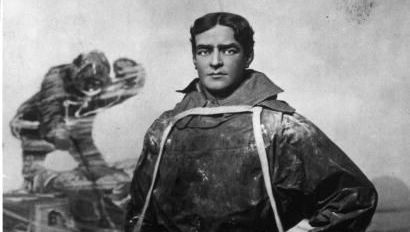
Ernest ShackletonImage:Getty Images
In some ways, Ernest Shackleton is the forgotten man in the history of Antarctic exploration, overshadowed by both the successes and tragedies of his famous rivals.
The following account describes the opening act of Sir Ernest Shackleton's expedition to the Antarctic in 1907-09, which followed Captain Robert F. Scott's earlier (1902-03) attempt to reach the geographic Pole. We take a look at Shackleton's association with Scott, the hardships of the Nimrod expedition, and the men who were with Shackleton.
Race to the South Pole
Just as the race to explore space captured people's imaginations in the latter part of this century, the quest to conquer the frozen and mysterious lands of the Arctic and Antarctic consumed explorers during the first part. Those who ventured into the vastness of the Polar regions were the popular heroes of the day. Like today's astronauts - or athletes - they commanded awe and respect. The Antarctic was Earth's final frontier. Certainly, the race for the South Pole was as dramatic and competitive as any race has been.
Ernest Shackleton wanted to be part of something that would bring honor to the British Empire. His interest in the South Pole began at age 16 when he left school to ship out to sea, much to his father's annoyance. By 24, he was certified to command a ship anywhere on the seven seas. The romance of the sea and the adventure led him to volunteer for Scott's 1902 National Antarctic Expedition, during which he served as Third Mate.
Shackleton and Scott
On that first voyage to the Antarctic, a rift between the Royal Navy officers, including Captain Scott, and Merchant Navy volunteers, such as Shackleton, led to dissension over the chain of command and over the mission's goals. Shackleton, in particular, disliked formality. Whether whaling seamen or Royal Navy captains, all were men of the sea to him. Stripes--or the lack of them--made no difference.
Despite the personality and rank differences, Scott selected Shackleton to take part in the trek towards the Pole. Shackleton would always be grateful to him for that, considering the men from whom he had to choose. The third member of the team was Dr. Edward A. Wilson, who became Shackleton's great friend.
The team members encountered numerous problems on that expedition with dogs, transport, diet, and weather. None of them knew how to use dogs and sledges. Physically, all of them had problems, which Wilson diagnosed as scurvy. They did not have the proper type of food to prevent this scourge, and, in the end, they did not bring enough to go around. Blizzards and whiteouts hampered their movement, and eventually, they had to abandon their goal of reaching the Pole.
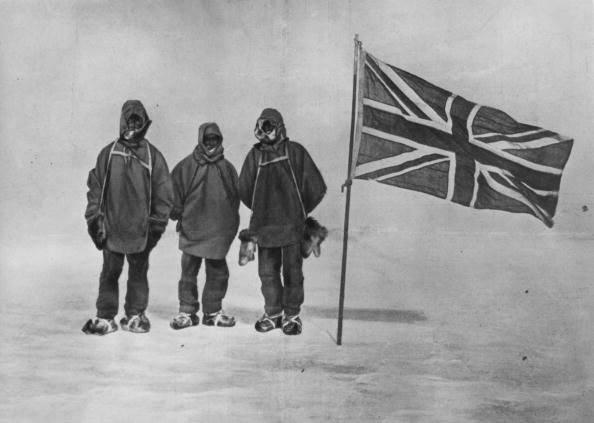
Shackleton and his men
Furthest South
At the same time, this foray yielded many positive results. They all reached 82 degrees, 15 minutes South. Scott and Wilson went on one mile further on 30th December, reaching the Furthest South, while Shackleton stayed behind, as he was too ill to proceed.
Ultimately, Wilson and Shackleton pressured Scott into abandoning the trek to the Pole. He seemed bent on carrying on, but the Pole was still far off, the three men had already eaten most of their food, and fatigue had taken a heavy toll on their strength. In addition, Shackleton developed scurvy. Had Shackleton not become ill, Scott might not have agreed to return as he did. As it was, they rushed from depot to depot. As ill as Shackleton apparently was, he still assisted with the sledging, although at one point he had to be carried briefly on the sledge. Afterward, he claimed that he was never as ill as Scott made it appear in his account, The Voyage of the Discovery. On 3rd February, 1903, they returned to the ship, just over three months and 960 miles after they began the journey.
Scott then sent Shackleton home, ostensibly to recover from his illness, but Scott may simply have wanted to rid himself of a rival. Shackleton arrived in London on 12th June, 1903. After stints as a journalist, secretary to the Royal Scottish Geographical Society, and an unsuccessful bid for a seat in Parliament, he announced plans for another Antarctic expedition in the March 1907 Geographical Journal. His objectives included geographical exploration and an attempt on the Pole, as well as collecting meteorological, geological, and biological data. But this second voyage also grew out of a personal need to prove to himself and to skeptics that he was capable of leading and completing an expedition.
He tackled the time-consuming and difficult tasks of acquiring financing, selecting a crew and ship, and arranging for stores. Thanks to the generosity of many who believed in his work, he soon felt ready to better Scott's record, and he next set his thoughts to selecting the companions who would accompany him on the shore party.
Read more
Assembling a team
Shackleton's first choice, his chum from the Discovery, "Billy" Wilson, declined Shackleton's invitation. Wilson later perished along with Scott while returning from the famous Terra Nova Antarctic expedition of 1912. Nevertheless, Shackleton assembled a first rate shore party for the British Antarctic Expedition, 1907: Lieutenant James A. Boyd, R.N.R., Sir Philip Lee Brocklehurst, assistant geologist; Bernard Day, motor mechanic; Ernest Joyce, in charge of the dogs; Alistair Forbes Mackay, second surgeon; Eric Marshall, chief surgeon, photographer, and cartographer; George Marston, artist; James Murray, biologist; Raymond Priestley, geologist and photographer; William Roberts, cook; and Frank Wild, in charge of provisions.
The ship Shackleton had originally set his sights on proved financially out of the question; he had to settle for an older vessel, the Nimrod. He considered his vessel's name, taken from a mighty hunter described in the biblical book of Genesis, to be a good omen. Once again, though, he had to make do with second best after his first choice for captain of the Nimrod did not accept his offer. If he had been superstitious, he might have heeded these signs. But, as Shackleton had already contracted for a dozen Manchurian ponies, dogs, sledges, and a pre-fabricated hut, and a benefactor had arranged a specially-built motor car, an Arroll-Johnston-he determined to proceed.
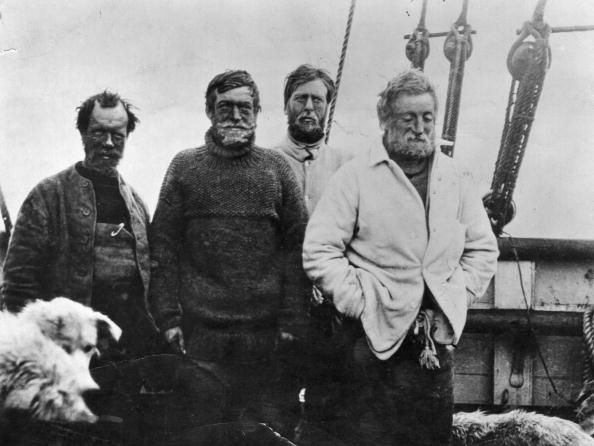
Shackleton and his team on the Nimrod
Dependence on cars
With the benefit of hindsight, many people today look back with amazement on the team's dependence on the motor car and Manchurian ponies. In fact, Shackleton spent time in Norway before the expedition, consulting two of the most illustrious Polar explorers, Fridtjof Nansen and Otto Sverdrup, who advised Shackleton against using these modes of transportation. In the end, however, he rejected this expert advice. The car, he reasoned, had been specially prepared for Antarctic conditions. And the ponies, Shackleton believed, could haul far more sledge weight than dogs. At the very least, he knew that his team could man-haul the sledges if necessary.
If Shackleton lacked good judgement in his choice of transportation, he made better decisions when it came to shelter. The expedition's hut, prepared by a firm in Knightsbridge, was prefabricated for ease of assembly, rather than transported whole, as Scott's had been. Scott's cumbersome hut had taken up precious cargo space on Discovery. Constructed of fir, Shackleton's hut was insulated with felt and shredded cork. This habitat of 33 x 19 feet would have to house 15 men in close proximity for many months.
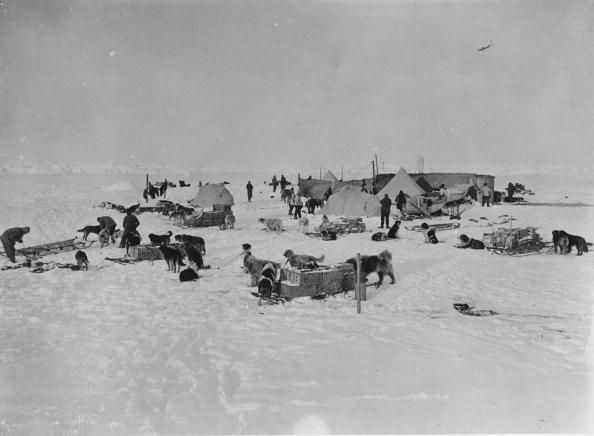
Camp Site
The journey begins
With great anticipation, Shackleton and his men set sail from London for Torquay in the south-west of England on 7th August 1907. On their way, they received a command to meet King Edward VII, Queen Alexandra, and other members of the Royal Family at Cowes. His Majesty conferred the Commander of the Victorian Order on Shackleton, as he had on Scott some five years earlier. Her Majesty handed Shackleton a Union Jack to place at the Pole. Later at Torquay, he bade farewell to his wife, Emily, his children, and his brother, Frank, a ne'er-do-well, who had recently been linked to the theft of the Irish crown jewels.
Shackleton took care of other business, rejoining Nimrod in Lyttleton, New Zealand. Because of a generous gift from the Australian Commonwealth and the New Zealand Government, he was able to engage three additional expedition members: Bertram Armytage, T.W. Edgeworth David, and Douglas Mawson. They set sail again on New Year's Day, 1908.
The ship Koonya towed them south to the Ice Barrier, allowing them to save coal they would badly need during their tenure in the Antarctic. They headed south through rough seas for some two weeks, dodging icebergs before passing through the Ross Sea ice into open water.
Shackleton's original plan had been to establish a base camp in King Edward VII Land, but due to the sea ice conditions, the team couldn't reach it. Also, the topography at the Bay of Whales had changed, so he decided not to chance a landing. Nimrod had only a short while before it would become frozen in the ice, and Captain England was nervous that his ship would become stuck fast before Shackleton found a place to land his stores, animals, motor car, and shore party.
After wrestling with his conscience, Shackleton made a controversial decision to revoke an agreement he had made with Scott in order to keep his men alive. Prior to Shackleton's departure, Captain Scott wrote and strongly suggested that Shackleton not use his 1902 Hut Point base or venture into McMurdo Sound, which Scott deemed "his territory." At the time Shackleton received this "suggestion," he had no thought of landing there, so he agreed to Scott's request. In an interview Shackleton's granddaughter, The Honourable Alexandra Shackleton, asserted, "Scott should never have asked Grandfather to make such a commitment; and Grandfather should never have given it. Scott considered it a personal betrayal and never forgave Grandfather. The absolutes were different then; it was life or death. The Establishment considered it a most dishonorable action, but it should have been understood that he had no choice."
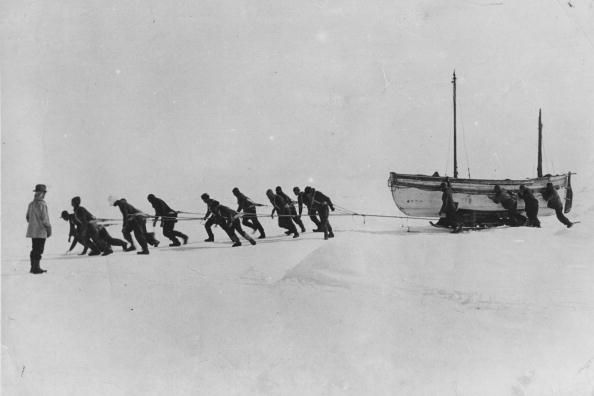
Shackleton and his team in action
Settling in
Shackleton's team finally offloaded near Cape Royds, about 20 miles north of Hut Point. It took them about 15 days to turn their hut into cramped but livable quarters. In order to make the best use of their small living space, they arranged the dining table so it could be pulled up to the ceiling. The men settled into a routine, trying not to get on each other's nerves.
Paired off, they moved into their 6 x 7-foot cubicles, which had names reflecting the occupants: Rogues' Retreat was Joyce and Wild's; The Pawn Shop reflected David and Mawson's untidy habits; Adams and Marshall's quarters were dubbed No. 1 Park Lane.
Wild and Joyce, having had a crash course in printing in London, set about printing the first book published in the Antarctic, Aurora Australis [the Southern Lights], with etchings by Marston. They had to keep a candle burning under the inking plate to prevent it from freezing.
A number of the expedition members captured historic moments on film. Shackleton later used these to prove how much they had accomplished, despite the fact that they did not reach the South Pole. Many of the photographs were reproduced in his book on the expedition, The Heart of the Antarctic.
They hoped to achieve several things that spring. First, the quartet of Adams, Marshall, Wild, and Shackleton would attempt to reach the South Geographic Pole, a 1,708-mile journey, with ponies pulling sledges. David, Mawson, and Mackay would trek to the South Magnetic Pole, a journey of some 1,200 miles. David's party used the motorcar to relay supplies to two depots, but it became mired in the soft snow of McMurdo Sound and soon was of no use.
Before the trek to the Poles, Shackleton assigned Adams, Brocklehurst, David, Mackay, Mawson, and Marshall to undertake the ascent of the volcano, Mount Erebus. All, except Brocklehurst, reached the summit on 10th March, 1908. Getting there had been a tremendous physical struggle. Having no mountaineering gear, as there had been no plan to attempt the climb, they man-hauled all their provisions to the 13,000-foot peak and were the first to ever look into the jaws of the volcano. Through extraordinary resourcefulness, courage, and dedication, the team achieved a triumph.
* Originally published in 1999.





Comments